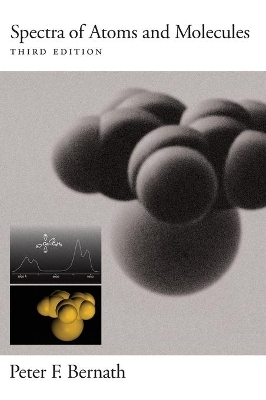
Spectra of Atoms and Molecules
Oxford University Press Inc (Verlag)
978-0-19-938257-6 (ISBN)
This much-needed new edition has been updated to include the 2010 CODATA revision of physical constants, and a large number of corrections and clarifications. Responding to student requests, the main new feature is the addition of detailed worked examples in each chapter. Spectra of Atoms and Molecules, 3e will help demystify spectroscopy by showing readers the necessary steps in a derivation, as well as the final result.
Peter F. Bernath is Professor of Chemistry and Biochemistry at Old Dominion University in Norfolk, Virginia.
Introduction
1.1 Waves, Particles, and Units
1.2 The Electromagnetic Spectrum
1.3 Interaction of Radiation with Matter
Molecular Symmetry
2.1 Symmetry Operations
2.2 Groups
2.3 Notation for Point Groups
3 Matrix Representation of Groups
3.1 Vectors and Matrices
3.2 Symmetry Operations and Position Vector Basis
3.3 Symmetry Operators and Atomic Basis Vectors
3.4 Symmetry Operators and Basis Functions
3.5 Equivalent, Reducible, and Irreducible Representations
3.6 Great Orthogonality Theorem
3.7 Character Tables
Quantum Mechanics and Group Theory
4.1 Matrix Representation of the Schr¨odinger Equation
4.2 Born-Oppenheimer Approximation
4.3 Symmetry of the Hamiltonian Operator
4.4 Projection Operators
4.5 Direct Product Representations
4.6 Integrals and Selection Rules
Atomic Spectroscopy
5.1 Background
5.2 Angular Momentum
5.3 The Hydrogen Atom and One-Electron Spectra
5.4 Many-Electron Atoms
5.5 Selection Rules
5.6 Atomic Spectra
5.7 Intensity of Atomic Lines
5.8 Zeeman Effect
5.9 Stark Effect
Rotational Spectroscopy
6.1 Rotation of Rigid Bodies
6.2 Diatomic and Linear Molecules
6.3 Rotational Line Intensities for Diatomic and Linear Molecules
6.4 Symmetric Tops
6.5 Asymmetric Tops
6.6 Structure Determination
Vibrational Spectroscopy
7.1 Diatomic Molecules
7.2 Vibrational Motion of Polyatomic Molecules
7.3 Selection Rules for Vibrational Transitions
7.4 Vibrational Spectra of Polyatomic Linear Molecules
7.5 Vibrational Spectra of Symmetric Tops
7.6 Vibrational Spectra of Spherical Tops
7.7 Vibrational Spectra of Asymmetric Tops
7.8 Vibration-Rotation Line Intensities
7.9 Fermi and Coriolis Perturbations
7.10 Inversion Doubling and Fluxional Behavior
Light Scattering and the Raman Effect
8.1 Background
8.2 Rotational Raman Effect
8.3 Vibration-Rotation Raman Spectroscopy
8.4 Rayleigh and Raman Intensities
Electronic Spectroscopy of Diatomics
9.1 Orbitals and States
9.2 Vibrational Structure
9.3 Rotational Structure of Diatomic Molecules
9.4 The Symmetry of Diatomic Energy Levels: Parity
9.5 Rotational Line Intensities
9.6 Dissociation, Photodissociation, and Predissociation
Electronic Spectroscopy of Polyatomics
10.1 Orbitals and States
10.2 Vibrational Structure of Electronic Transitions
10.3 Vibronic Coupling: The Herzberg-Teller Effect
10.4 Jahn-Teller Effect and Conical Intersections
10.5 Renner-Teller Effect
10.6 Nonradiative Transitions: Jablonski Diagram
10.7 Photoelectron Spectroscopy
10.8 Rotational Structure: H2CO and HCN
10.9 Intensity of Transitions
| Erscheinungsdatum | 31.12.2015 |
|---|---|
| Zusatzinfo | 240 |
| Verlagsort | New York |
| Sprache | englisch |
| Maße | 257 x 180 mm |
| Gewicht | 1021 g |
| Themenwelt | Naturwissenschaften ► Chemie ► Analytische Chemie |
| Naturwissenschaften ► Physik / Astronomie ► Atom- / Kern- / Molekularphysik | |
| ISBN-10 | 0-19-938257-3 / 0199382573 |
| ISBN-13 | 978-0-19-938257-6 / 9780199382576 |
| Zustand | Neuware |
| Haben Sie eine Frage zum Produkt? |
aus dem Bereich


